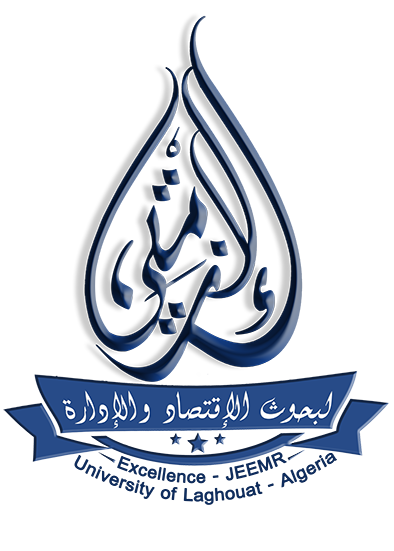The Role of Digital Transformation in Mitigating Organizational Obesity -A Field Study at Sonelgaz-Boumerdes Institution
Abstract
This study aimed to shed light on the role of digital transformation in alleviating organizational obesity with its dimensions (functional redundancy, functional slack, and decreased productivity). Its importance lies in the scarcity of studies addressing organizational obesity and how digital transformation can mitigate it. To address this issue, a questionnaire was designed and distributed to a sample of 54 employees at Sonelgaz-Boumerdes Institution. The descriptive analytical method was employed using SPSS V29 for statistical description, while the Partial Least Squares Structural Equation Modeling (PLS-SEM) method was utilized through SmartPLS 4 software for hypothesis testing and result analysis. Ultimately, the study concluded that digital transformation contributes to alleviating organizational obesity across its three dimensions in Sonelgaz-Boumerdes Institution. The study recommended the utilization of digital transformation as an effective means to mitigate organizational obesity.
References
Appleby, C., Hendricks, J., Wurz, J., Shudes, C., Shukla, M., & Chang, C. (2021). From a buzzword to an imperative for health systems. Deloitte.
Chamorro-Premuzic, T. (2021, November 23). The Essential Components of Digital Transformation. https://cutt.us/eicd3
Ibtihal Faris, & Ali, M. (2021). The Effect of Functional and Administrative Sagging on the Production Process. International Journal of Innovation, Creativity and Change, 12(7), 480–502. https://doi.org/10.13140/RG.2.2.29253.17124
Li, F. (2018). The digital transformation of business models in the creative industries: A holistic framework and emerging trends. Technovation, 1–45. https://doi.org/10.1016/j.technovation.2017.12.004
McKinsey. (2023). What is digital transformation? McKinsey & Company.
Mohammd, Q. J., Ghanim, S. S., & Najim, N. S. (2022). The Role of Administrative Slouch in Expanding the Hidden Economy. Journal of Business and Management Studies, 4(2), 492–500. https://doi.org/10.32996/jbms.2022.4.2.37
Muktamar B, A., Bachtiar, A., Guntoro, G., Riyantie, M., & Ridwan, N. (2023). The Role of Leadership in Digital Transformation Management in Organisations. Jurnal Minfo Polgan, 12(1), 1306–1314. https://doi.org/10.33395/jmp.v12i1.12731
Schallmo, D. (2018). Digital Transformation in a Nutshell.
Yokogawa. (2020). Digital Transformation in Process Industries. Yokogawa Electric Corporation.
Zhang, J., Long, J., & Von Schaewen, A. M. E. (2021). How Does Digital Transformation Improve Organizational Resilience?—Findings from PLS-SEM and fsQCA. Sustainability, 13(20), 11487. https://doi.org/10.3390/su132011487
Alhadraoui, R.H.A & Chakir,A,y.(2002). Anʻkās taṭbīq istirātījīyah al-taḥawwul al-raqmī ʻalá alrshāqh al-tanẓīmīyah li-Wizārat al-ittiṣālāt al-ʻIrāqīyah. Journal Of AL-Turath University College, 34, 71 – 83.
Altai, Y.H.S ,& Muhammed,A,A,A.(2012). al-Istijābah al-Istirātījīyah wa-dawruhā fī al-ḥadd min altkāsl al-waẓīfī (dirāsah maydānīyah fī Dīwān al-Muḥāfaẓah). AL Ghary Journal of Economic and Administrative Sciences, 14 (2), 159 – 181.
Khalif,S.A.(2012). Albdānh al-tanẓīmīyah wa-atharuhā fī ʻamalīyat al-Taṣaḥḥur al-waẓīfī dirāsah istiṭlāʻīyah li-ārāʼ ʻayyinah min al-ʻāmilīn fī al-Maʻhad al-tiqanī al-Mawṣil. Majallat dawrīyah niṣf sanawīyah taṣdur ʻan Kullīyat al-Idārah wa-al-Iqtiṣād, 05 (09), 124 – 147.
Mahmoud,N.A.S, Al-essawi ,H,M,A , Alzubai,M.H.A.A.(2023). Dawr li-qiyādat alrshyqh fī al-ḥadd min albdānh al-tanẓīmīyah dirāsah istiṭlāʻīyah fī Dāʼirat alṣḥt-ṣlāḥ al-Dīn. Majallat Iqtiṣādīyāt al-Aʻmāl, 5 (2), 201 – 240

This work is licensed under a Creative Commons Attribution-NonCommercial 4.0 International License.








